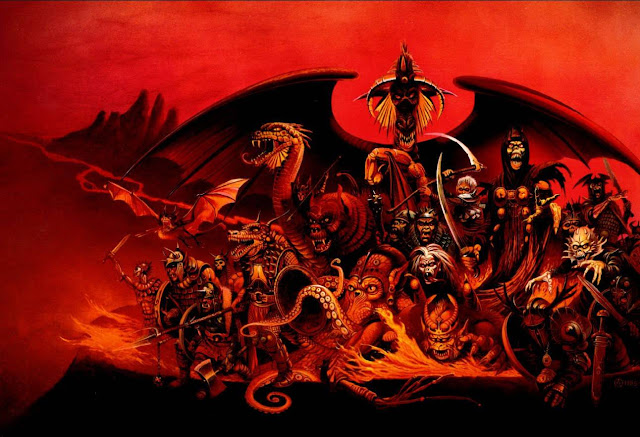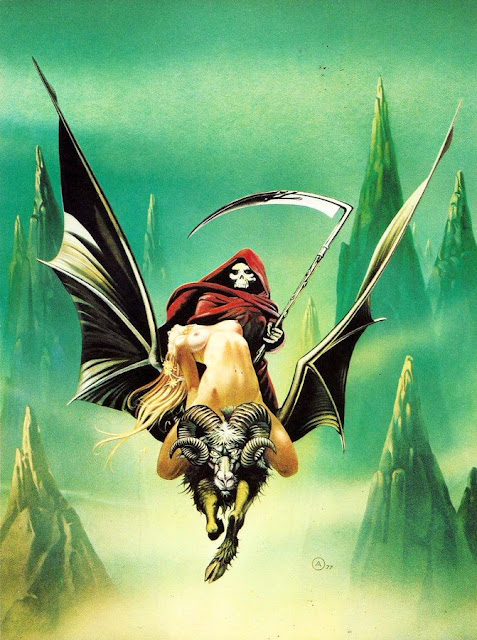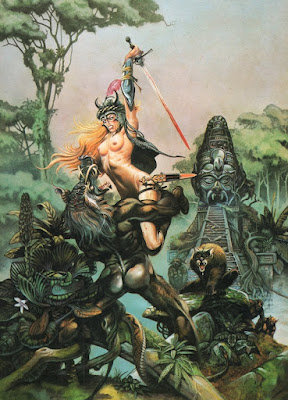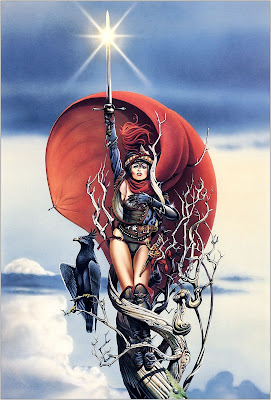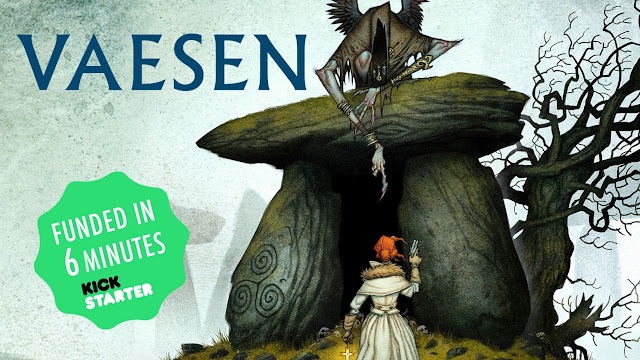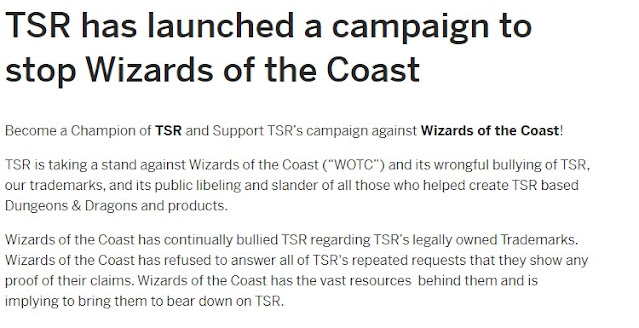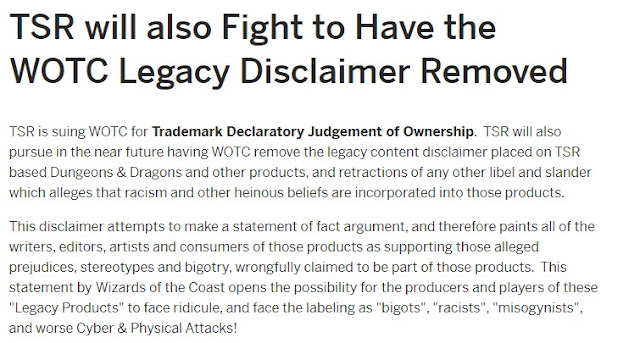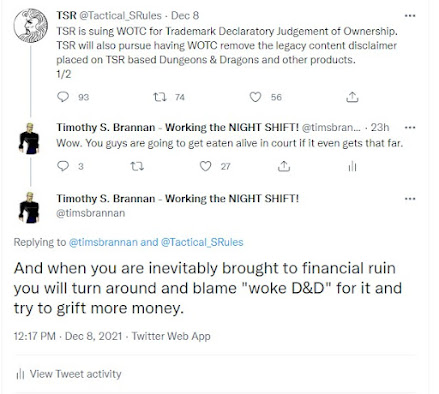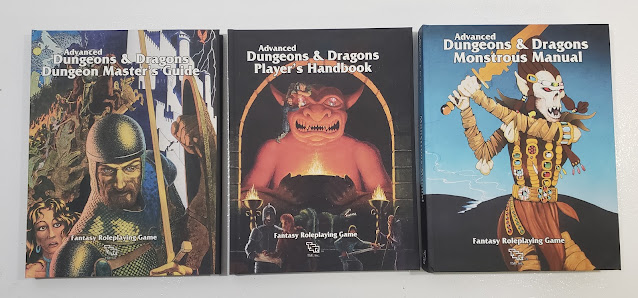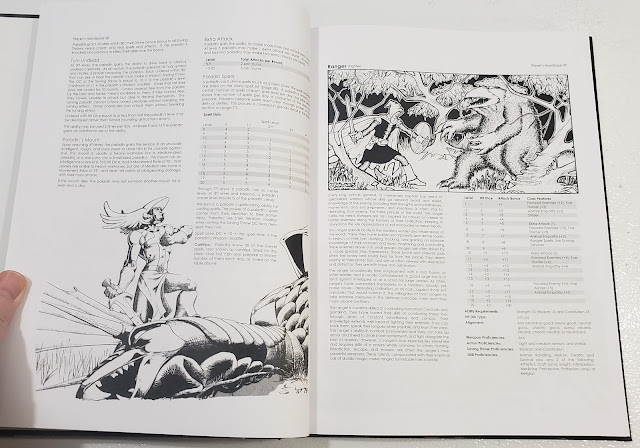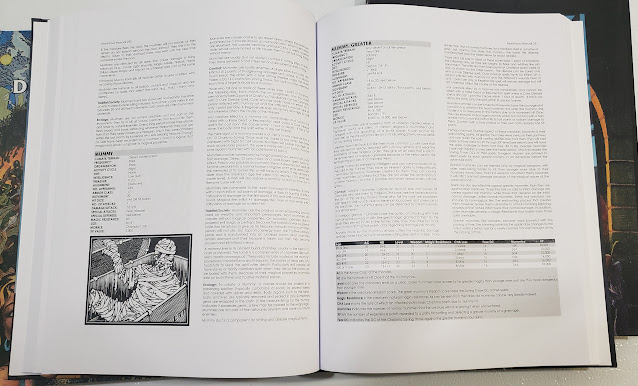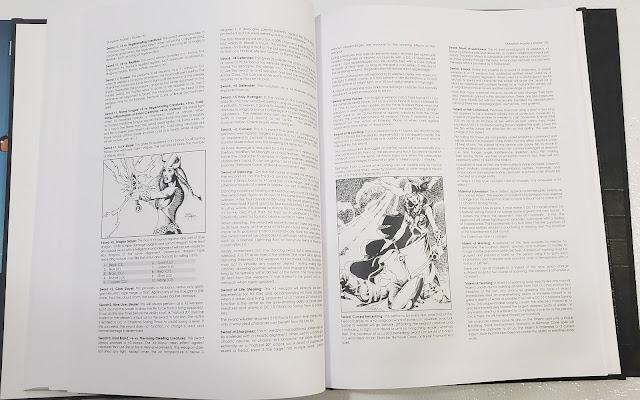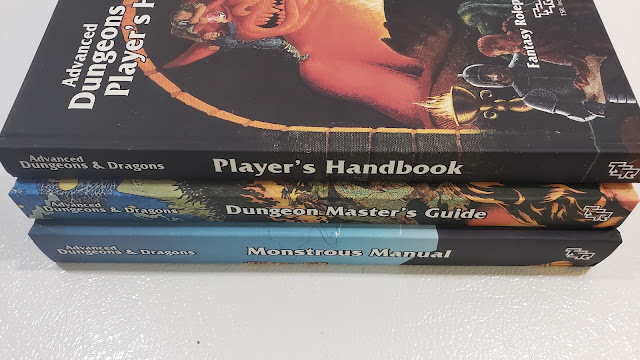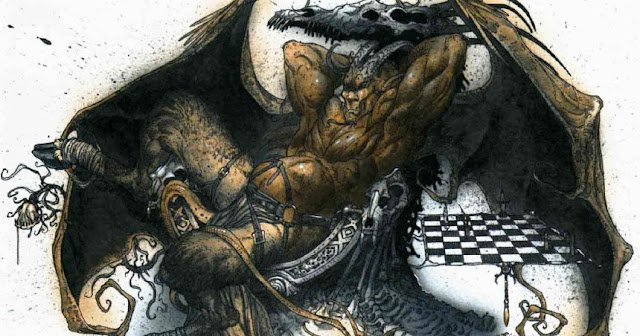2001: Godlike
—oOo—
 As much as the noughties was a decade dominated by the d20 System and the rise and fall of the third-party Dungeons & Dragons publisher, it was also the decade of two genres. One was pirates, the other was World War 2. The former was certainly given a big push by the release in 2003 of Pirates of the Caribbean, and would see titles such as Swashbuckling Pirates, Pirates of the Spanish Main, and Swashbucklers of the 7 Skies being published. The latter was spurred on by the anniversary of the USA’s entry into World War 2 with the attack on Pearl Harbour, and indeed, in that sixtieth anniversary three World War 2 roleplaying games would be published—Gear Krieg The Roleplaying Game from Dream Pod 9, GURPS WWII from Steve Jackson Games, and Godlike: Superhero Roleplaying in a World on Fire, 1936-1946. Over the course of the next decade, numerous World War 2 themed roleplaying games, from the small such as Battleforce Bravo from Deep7 Press to Weird War Two D20: Blood on the Rhine from Pinnacle Entertainment. These five represent the differing approaches taken to what is a defining period in twentieth century history. Both Battleforce Bravo and GURPS WWII played it straight and kept it to the history (that is, until GURPS WWII Classic: Weird War II), but the others would go in a different direction, adding another genre. Weird War Two D20: Blood on the Rhine added horror, Gear Krieg The Roleplaying Game added combat walkers, and Godlike added superheroes.
As much as the noughties was a decade dominated by the d20 System and the rise and fall of the third-party Dungeons & Dragons publisher, it was also the decade of two genres. One was pirates, the other was World War 2. The former was certainly given a big push by the release in 2003 of Pirates of the Caribbean, and would see titles such as Swashbuckling Pirates, Pirates of the Spanish Main, and Swashbucklers of the 7 Skies being published. The latter was spurred on by the anniversary of the USA’s entry into World War 2 with the attack on Pearl Harbour, and indeed, in that sixtieth anniversary three World War 2 roleplaying games would be published—Gear Krieg The Roleplaying Game from Dream Pod 9, GURPS WWII from Steve Jackson Games, and Godlike: Superhero Roleplaying in a World on Fire, 1936-1946. Over the course of the next decade, numerous World War 2 themed roleplaying games, from the small such as Battleforce Bravo from Deep7 Press to Weird War Two D20: Blood on the Rhine from Pinnacle Entertainment. These five represent the differing approaches taken to what is a defining period in twentieth century history. Both Battleforce Bravo and GURPS WWII played it straight and kept it to the history (that is, until GURPS WWII Classic: Weird War II), but the others would go in a different direction, adding another genre. Weird War Two D20: Blood on the Rhine added horror, Gear Krieg The Roleplaying Game added combat walkers, and Godlike added superheroes.Godlike: Superhero Roleplaying in a World on Fire, 1936-1946 did superhero roleplaying and superheroes in World War 2 like no other. In supplements like Glory Days for Brave New World and scenarios like All This and World War II for Marvel Super Heroes, the focus is traditionally on the superhero first, not the soldier. Although Godlike was a superhero roleplaying and an alternate history game in which superheroes existed and influenced the course of the war—and beyond, they would not change the outcome of the war. The World War 2 of Godlike would still be won by men and machinery, by grit and determination, and when the Talents—those blessed with the superpowers or miracles which set them apart from ordinary men—of the Allies met the Übermensch of the Axis powers, they were soldiers first, superheroes second. Godlike is not a superhero setting in which the superheroes, the Talents, wear spandex. Instead, they wear a uniform and they serve their country. It is also not a Four Colour setting, but gritty. Despite their amazing abilities, Talents do die, whether that is due to combat with an Übermensch or an artillery barrage.
The alternate history of Godlike begins in 1936 when Der Flieger—‘The Airman’—appeared in the skies over the Berlin Olympics. He was the first Talent, and as Europe moved towards war, more would appear. Pevnost, a Czechoslovakian resistance fighter who could step through one door and out of any door he had previously stepped through, enabling him to traverse hundreds of miles in an instance. He would support the underground resistance throughout the war. As Der Flieger destroyed the Polish airforce, a Polish Talent, Cien appeared, who was capable of manipulating objects touched by his shadow, the Finnish Viljo, became one with the arctic snow and fought the Soviet invaders, and the Danish schoolboy, Vogel, found himself invulnerable to any attack he was aware of. As the Nazis occupied more and more of Europe, more Talents appeared amongst the local populations, many of whom would become heroes of their nations. The first British Talent was Jumping Johnny, capable of leaping twenty-seven miles in a single bound and land with a destructive bang, whilst The Indestructible Man, the USA’s first Talent, immune to any damage he was aware of, up to and including as was tested after the war, a ten-megaton nuclear bomb. More and more Talents would manifest throughout the war and around the world, as men and women were subject to the stresses and strains of the war. Despite the Soviet attempts to ‘biologically re-educate’ subjects into manifesting as Talents, the resulting Baba Yaga escaped, mad and willing to attack Soviet and Nazi forces alike. The Nazis conscripted its Übermensch into special SS brigades, whilst the Allies transferred its Talents into Talent Operations Command and trained them as commandos before organising them into Talent Operation Groups, or squads, which would typically be attached to standard forces or used on special missions.
In Godlike, player take the roles of Talents, soldiers with superpowers or miracles who serve in Talent Operation Groups. A character has six stats, Body, Brains, Command, Cool, Coordination, and Sense, rated between one and five, with two being average. Similarly, skills are rated between one and five. Beyond this, stats and skills can have Hyperstats and Hyperskills, so a Talent can have Hyper-Body and be super strong, or Hyper-Intimidation, and be incredibly imposing! Then there are Miracles. Certain traditional superpowers are unknown in the world of Godlike: Superhero Roleplaying in a World on Fire, 1936-1946—mind control or reading, absorption or imitation of other Talents, the ability to create Talents, time travel, unlimited healing powers, and actual super-science—though Goldberg Science and the creation of gadgets is possible. A wide array of cafeteria-style Miracles is given. This ranges from Aces, which makes the Talent incredibly lucky, Break, which enables a Talent to puncture or smash objects beyond Human capability, and Dampen, which allows him to reduce or negate a physical effect of a Talent to Side Step, with which a Talent can avoid a disaster or attack, Time Fugue, which enables a Talent to stop time for a single object or creature, and Zed, which can be used to negate the ability of another Talent. All of the Miracles come with Power Stunts, Extras, and Flaws, which all adjust the cost of the Talents, and there are also prebuilt, ready-to-play, Cafeteria Power-Sets—though only a handful of them. They include The Blaster, The Brain, The Bruiser, The Flyer, and so on.
There is also the option for a player to build his Talent’s Miracles as per other point-buy systems in other superhero roleplaying games. Fundamentally though, the tone and power level of Godlike means that certain superhero archetypes are challenging, even impossible to build. To build a Talent with the powers of flight and blast rays is possible, but expensive, but add in invulnerability, and it becomes prohibitively expensive. This is because Miracles—and also Hyperstats and Hyperskills—are bought as die types. Standard dice are the least expensive, Wiggle dice the most expensive, and Hard dice in between. Figure in Qualities—Attacks, Defends, Useful out of Combat, and Robust—and the cost also goes up, although a player could remove them to reduce the cost, but with the loss of utility. Miracles can also be modified by Extra, Flaws, and Power Stunts, which in turn adjusted the cost. Another limiting factor is the number of Will Points a Talent is built on. Godlike gives the stats for the first ten Talents to appear, their costs ranging from twenty-five to one-hundred-and-fifty Will Points, but the majority have Miracles way out of the league of beginning Talents. In the default campaign setting of the Talent Operations Group, a player is given twenty-five Will Points with which to purchase Hyperstats, Hyperskills, and Miracles. It is not a lot and it makes it challenging to create Talents without resorting to Hyperstats or Hyperskills. Nevertheless, it is possible to create interesting Talents, not all of them necessarily designed for combat.
To create a Talent, a player assigns six points to his Talent’s stats—which already begin at one, assigns twenty points to skills, and if playing in the Talent Operations Group campaign, receives training in another eighteen points’ worth of skills. Lastly, he has twenty-five Will Points to spend on Hyperstats, Hyperskills, and Miracles. As well this, a player should determine his Talent’s background, nationality, age, family, education, motivations, and so on, to flesh out the character.
Our sample Talent is Technician Third Grade Theodore Huffman, who was studying piano at the Juilliard School of Music in New York when his draft number came up 1943. After basic training he was assigned to Special Services and performed piano concerts in the USA, and then England and North Africa. In early 1944, the convoy he was in, was ambushed by the Germans and the truck he was driving blown up. He was thrown from the vehicle and knocked unconscious. It was then that his Talent manifested—Billy Bones. Whilst Theodore was unconscious, his skeleton got up, grabbed a machine gun and proceeded to fight the ambushers, killing most of them, and driving the rest off. When relief arrived, they discovered Huffman asleep and Billy Bones brashly playing jazz on the piano and smoking a cigar. As a Talent, Billy Bones fights when Huffman cannot, and is stronger and faster than Huffman. He also smokes when Huffman does not, and whilst Huffman is a classical pianist, Billy Bones plays music more popular with his fellow soldiers.
Technician Third Grade Theodore Huffman, ‘Billy Bones’, TOG-242
Body 2 Coordination 2 Sense 2
Brains 2 Command 3 Cool 1
Base Will 4
Current Will 4
Motivations: Survive the war; Become a better musician
Skills: Brawling 1 (3d), Climb 1 (3d), Cryptography 2 (4d), Dodge 1 (3d), Drive (Automobile) 1 (3d), Education 2 (4d), Endurance 1 (3d), Explosives 1 (3d), Grenade 1 (3d), Hearing 2 (4d), Knife Fighting 1 (3d), Language (French) 2 (4d), Machine Gun 1 (3d), Map Reading 1 (3d), Navigation (Land) 1 (3d), Perform (Piano) 3 (6d), Perform (Sing) 1 (4d), Pistol 1 (3d), Radio Operation 1 (3d), Rifle 1 (3d), Sailing (Sailboat) 1 (3d), Stealth 1 (3d), Submachine Gun 1 (3d), Survival 1 (3d), Swim 1 (3d), Tactics 1 (3d)
Talents (25 Will Points)
Alternate Form 2hd (Qualities: Attacks, Defends, Robust, Useful Outside of Combat. Base Cost: 5/10/20. Extra: Endless +1/+2/+4, Extra: Unconscious +1/+2/+4; Flaw: Peace of Mind (Asleep) -2/-4/-8; Flaw: Mental Strain -2/-4/-8; Final Cost 3/6/12; 12 points).
Hyperstat: Body +3d (Base Cost: 2/5/10. Flaw: Attached to Alternate Form -1/-2/-4; Final Cost 1/3/6; 3 points).
Hyperstat: Coordination +3d (Base Cost: 2/5/10. Flaw: Attached to Alternate Form -1/-2/-4; Final Cost 1/3/6; 3 points).
Hyperstat: Cool +3d (Base Cost: 2/5/10. Flaw: Attached to Alternate Form -1/-2/-4; Final Cost 1/3/6; 3 points).
Hyperskill: Submachine Gun +2hd (Base Cost: 1/3/7. Flaw: Attached to Alternate Form -1/-2/-4; Final Cost 1/1/3; 2 points).
Hyperskill: Perform (Piano) +2hd (Base Cost: 1/3/7. Flaw: Attached to Alternate Form -1/-2/-4; Final Cost 1/1/3; 2 points).
Although there is a wide range of Miracles listed in Godlike, the list is not extensive, and it would not be until the supplement, Will to Power when the roleplaying game received Miracles such as Size Shift and Unconventional Move. (The supplement also added a range of aircraft which were not included in the core rules—an issue potentially if one of the player Talents could fly.) Nevertheless, between the Godlike and Will to Power, both Game Master and player had access to a decent range of Miracles, enabling both to create interesting Talents. (The following example Talent was created using the extra content from Will to Power.)
Dorothy Murray was fourteen when she was evacuated from London. Unhappy with life away from her parents she ran away and returned to life in the capital. When the family house was bombed, and she found herself buried under rubble, her Talent manifested—she was able to tunnel her way out. At first she thought it was luck, but during later raids, she could hear the cries of those trapped and knew where they were. She began to experiment her powers and by the height of the Blitz, was going out nightly to tunnel into the rubble of bombed houses to rescue the survivors. Anyone pulled free always remembered the glow of the girl who came to rescue them and carry them to safety. The newspapers nicknamed her the ‘Angel of the Blitz’.
Dorothy Murray ‘Angel of the Blitz’
Body 2 Coordination 2 Sense 2
Brains 2 Command 2 Cool 2
Base Will 4
Current Will 4
Motivations: Help people with her Talent; Finish school
Skills: Athletics 1 (3d), Education 1 (3d), First Aid 1 (3d), Health 1 (3d), Hearing 1 (3d), Inspire 1 (3d), Language (Latin) 1 (1d), Mental Stability 1 (3d), Perform (Violin) 1 (3d), Run 1 (3d)
Talents (25 Will Points)
Unconventional Move: Tunnelling 4d+2wd (Qualities: Attacks, Defends, Robust, Useful Outside of Combat. Base Cost: 5/10/20. Extra: Endless +1/+2/+4, Extra: Passenger +1/+2/+4. Flaw: Beacon -4/-8/-16, Flaw: Glows -1/-2/-4, Flaw: Specific Material (Rubble) -1/-2/-4; Final Cost 1/2/4; 12 points).
Hyperstat: Body +8d (Base Cost: 2/5/10. Flaw: Attached to Unconventional Move -1/-2/-4; Final Cost 1/3/6; 8 points).
Detection: Humans 4d (Qualities: Defends, Robust, Useful Outside of Combat. Base Cost: 4/8/16. Flaw: Human Trapped in Rubble/Underground -1/-2/-4; Flaw: Attached to Alternate Form -1/-2/-4; Final Cost 2/4/8; 4 points).
Mechanically, Godlike uses what would become known as ‘Ore’ or the ‘One-Roll Engine’. This is a dice pool system, usually formed of the appropriate Stat plus Skill, for example, Coordination plus Rifle or Command plus Perform (Piano), the aim being not to roll success, but get matches—pairs, triples, and so on. Neither player nor Game Master roll more than ten dice—although actually rolling that many dice is not common. If any of the dice match, then the character has succeeded. However, the more successes rolled, the wider the result is and the faster it is, and the higher the set of matches, the more effective it is. Carried over into combat, the width of the roll will determine the speed of the attack and how much damage is inflicted, whilst its height will determine exactly where the hit was made. Taking damage is not only physically injurious, but will negate dice in an attacker’s pool, so going first is almost a must, but dodging can ‘gobble’ up dice if successful, potentially breaking up matching sets. Although damage inflicted can be stunning, killing, or stunning and killing, combat can be brutal in Godlike, so players had better be warned ahead of play. Leaping into a game and expecting bullets to bounce off your hero’s chest just because is a sure-fire way to get him killed. Overall, the system is elegant, easily handles multiple actions, and plays fast, although it does take some adjustment from the traditional rote of rolling for initiative, rolling to hit, rolling for damage, and so on.
However, there are a couple interesting wrinkles which comes into play once Hyperstats, Hyperskills, and Miracles are figured. There are two other die types beyond the standard type. The medium cost die type is the Hard die. When this is in a pool and rolled, it is always set at a ten. This means that with a pair of Hard dice, a Talent will not always succeed, he will always do so with the maximum effect possible. The most expensive die type is also the most flexible. The Wiggle die can be set to any number, either to create a set or widen a set. Effectively, both give a player more control over his Talent’s ability to bring his Hyerstats, Hyerskills, and Miracles into play, especially as the dice pools for these increase in size—and it is generally easier to improve an already existing Talent rather than select a completely new one.
Perhaps the most enjoyable aspect of Godlike is the extensive timeline which covers the ten years from the Berlin Olympics of 1936 to the beginning the Cold War in 1946. It is richly detailed, mixing in both the actual history with the alternate history of Godlike, but keeping the two sperate. The entries which involve Talents are clearly marked with a bullet hole. This is supported by an equally interesting exploration of the wider background to Godlike and the appearance of Talents, especially how society at large reacted to them. The racism and sexism rampant throughout societies in the period is also acknowledged, but notes that despite that the targets of both played major roles in the global conflict. In the main, the role of Talents in Godlike—at least in Godlike: Superhero Roleplaying in a World on Fire, 1936-1946—is focused upon military and special operations style campaigns. This is understandable given that it is the major role of Talents throughout the war, and perhaps other types of campaigns, perhaps with a more diverse range of characters might have come had the publisher had the opportunity. Nevertheless, there is nothing to stop the Game Master using the content in Godlike: Superhero Roleplaying in a World on Fire, 1936-1946 and backed up with research of her own from running other types of campaigns set within the Godlike universe.
Godlike: Superhero Roleplaying in a World on Fire, 1936-1946 is further supported with a wide arsenal of equipment used by both the Allied and Axis powers, from small arms to armoured vehicles. The Game Master is given good advice on running a Godlike campaign, and the following details of the Talent Operations Group campaign is accompanied by a complete write-up of a sample TOG squad. This nicely showcases some of the possibilities using the Miracle creation rules earlier in the book. Alternatives and options suggest ways in which a campaign can be adjusted to allow Talents to be even more ‘godlike’, right up to a Four Colour-style campaign, but these do push the setting away from its gritty and very much soldier-first feel. Rounding out the book are the aforementioned write-ups of the first ten Talents to appear and since the book was published in 2001, rules for running a Godlike campaign under the d20 System. These are decently done, but feel superfluous now.
Physically, Godlike: Superhero Roleplaying in a World on Fire, 1936-1946 is sturdy black and white hardback. It perhaps feels a little odd in its ordering of its content, with explanations of the rules, mechanics, and character creation coming before the roleplaying game’s detailed background. Without the latter, the rules do lack context, but with perseverance the reader will get to the richly detailed background and begin to put everything together. The book is well written and illustrated throughout with black and photographs manipulated to add in the presence of the Talents in each and everyone. There is something quite odd about many of them, their slightly off kilter perspective giving them a sense of the unearthly.
Godlike is lacking a number of elements. Mostly obviously a scenario, but World War 2 is such a familiar setting that a Game Master should be able to develop something of her own with relative ease. It is lacking details of the aircraft—of either side, but that would be addressed in Will to Power. Perhaps its major omissions are the lack of perspectives from either a female point of view or a non-American point of view—and to be fair, there is some truth to both omissions. Yet the focus of Godlike: Superhero Roleplaying in a World on Fire, 1936-1946 is on the soldier on the front lines and beyond them, and not necessarily on the home front, and the role might very well have been more fully explored in subsequent supplements—for example, if a supplement devoted to the Russian Front had been published. The authors did publish scenarios in which women played a significant role, and to be fair, there is only just so much that can be covered in a book, even a core book like Godlike. Plus again, there is nothing to stop the Game Master, backed up with some research from running a campaign where women can play a major role. The other emphasis, that of the US soldier and the role of the USA in World War 2 is present in Godlike, but again to be fair, the roleplaying game was published in a year which was the anniversary of the entry of the USA into World War 2 and that emphasis could be found across all media. However, throughout the alternate history of Godlike, the roles of non-US Talents and their stories and contributions are highlighted again and again, each time working as potential inspiration for stories and scenarios which do not necessarily involve the USA. So ultimately, that emphasis is not strong as it could have been.
Godlike: Superhero Roleplaying in a World on Fire, 1936-1946 would go on to spawn a number of supplements and scenarios, including Will to Power and the campaign, Black Devils Brigade: The First Special Service Force and the Italian Campaign, 1943–1944. Its mechanics would have a wider influence, the One-Roll Engine appearing eventually on its own in Wild Talents, a sequel of sorts to Godlike, but which also stood alone and enabled a Game Master to run a more traditional style of superhero campaign. It in turn would give rise to some wildly imaginative campaign settings, including Wild Talents: Progenitor, Wild Talents: The Kerberos Club, and Wild Talents: This Favored Land.
Then published by Hawthorn Hobgoblynn Press, but later Arc Dream Publishing, Godlike: Superhero Roleplaying in a World on Fire, 1936-1946 would be one of the first roleplaying games I reviewed and certainly the first I reviewed after being contacted directly by the publisher and asked to review. I can remember the surprise when it happened, even when it happens today, I am still surprised and even humbled by the trust that publishers place in me in asking me to review their books. Godlike was worth that trust, because it was a great game in 2001 and it still is in 2021. The combination of Greg Stolze’s elegant mechanics with Dennis Detwiller’s richly developed background is a grim and gritty take upon the superhero genre, something that still stands out today as being different and stood out even more in 2001 against the backdrop of the d20 System boom and the tone taken by the other World War 2 roleplaying games then being released. Godlike: Superhero Roleplaying in a World on Fire, 1936-1946 is an amazing piece of writing and design which shows how even as miraculous powers change the world, the soldier—even the soldier Talent, not only has to survive that world, but stand up and still be a hero in that world.






